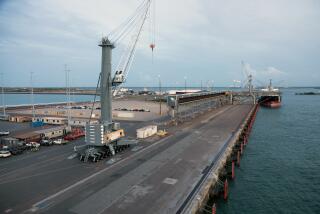Shanghai Port, Firm Sign Deal
- Share via
SHANGHAI — The world’s fastest-growing port city joined hands with a leading global transportation conglomerate Tuesday to manage China’s largest container terminal.
The partnership between Shanghai and Denmark’s APM Terminals signals the enormous interest of multinational firms in capitalizing on Shanghai’s extraordinary growth. It also marks the rising importance of Shanghai as a regional economic powerhouse.
Few ports’ growth could compare with the meteoric rise of Shanghai from a backwater about a decade ago to one of the world’s biggest trading hubs.
In 1995, Shanghai ranked 20th in the world, but booming international trade moved it to No. 5 this year. If the growth continues, the city is expected to rank No. 3 in a few years and eventually upset leaders Hong Kong and Singapore.
“Shanghai is kind of the new kid on the block in this industry,” said Richard Nicholson, general manager for development in China for A.P. Moller Group, the shipping giant’s parent company. “But Shanghai is on the way up and fast.”
With the exception of last year, when the impact of the Sept. 11 terrorist attacks slowed the pace of growth to about 13%, container traffic at the port has expanded more than 20% every year for the last 10 years.
“At that rate, the new terminal is going to be full in another two years or so,” Nicholson said. “They will need to build more.”
In fact, Shanghai plans to begin construction next year of a deep-water port on an island southeast of the city. When completed, it will substantially expand the city’s container capacity and cement its role as an international shipping center.
Without a new port, it will be tough for Shanghai to compete effectively against its regional rivals, including third-place South Korea and fourth-place Taiwan, in terms of size or efficiency.
Meanwhile, as mainland China’s largest port, Shanghai will continue to be overtaxed by a bustling domestic cargo market and increasing regional trade now that China has joined the World Trade Organization. The new terminal, which is expected to receive its first ship’s call in February, will be the largest in the current port of Shanghai. It will help speed up the turnaround time for larger vessels that are hampered by the Shanghai harbor’s relatively shallow waters.
“We expect the [new terminal] to lead China in performance and efficiency,” Lu Haihu, Shanghai Port director, said in a statement.
APM Terminals operates more than 30 public terminals, including one at the Port of Los Angeles. The choice of running these two Pacific Rim piers was no accident.
“Of all the action in world trade, the biggest by far is the transpacific trade,” Nicholson said.
More to Read
Sign up for Essential California
The most important California stories and recommendations in your inbox every morning.
You may occasionally receive promotional content from the Los Angeles Times.













